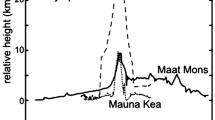Abstract
THE Sierra Leone Rise, located in the east equatorial Atlantic, forms a discontinuous chain of seamounts as shallow as 2 km extending with a general NE–SW trend from near the Sierra Leone coast of Africa, to the St Paul fracture zone near the Mid-Atlantic Ridge (Fig. 1). The origin of this feature has remained a topic of discussion. Sheridan et al.1 have hypothesised that the Sierra Leone Rise is a volcanic structure formed at the beginning of the opening of the Atlantic in the early Cretaceous period. The twin features of the Sierra Leone and the Ceara Rises are probably of oceanic origin and were created 80 Myr ago or later in their present-day position with respect to Africa and South America2. The Atlantic ocean exhibits several similar aseismic structures which appear symmetrically oriented with respect to the mid-oceanic ridge, such as the Walvis–Rio Grande Rise and the Iceland Faeroes–Iceland Greenland Ridges. These structures are volcanic edifices having a composition similar to that found in their associated islands3–7. Deep sea drilling of the Ceara Rise8,9 penetrated a basaltic basement of the upper Cretaceous period (Maestrichtian) (Leg 39, Site 354). Similarly, a DSDP hole (Leg 41, Site 366) on the Sierra Leone Rise, penetrated sediments of the same period, without reaching basement10. We report here the discovery of alkali-rich volcanics in an area of the Sierra Leone Rise. The sediment overlying the rock fragments is aged ∼45 Myr.
Similar content being viewed by others
References
Sheridan, R. E., Houtz, R. E., Drake, C. L. & Ewing, M. J. geophys. Res. 74, 2512–2530 (1969).
Sibuet, J. C. & Mascle, J. J. geophys. Res. (in the press).
Bott, M. H. P., Browitt, C. W. A. & Stacey, A. P. Mar. Geophys. Res. 1, 328–351 (1971).
Hekinian, R. Nature, Phys. Sci. 239, 91 (1972).
Goslin, J., Mascle, J., Sibuet, J. C. & Hoskins, H. Geol. Soc. Am. Bull. 85, 619–632 (1974).
Hekinian, R. Contrib. Mineral. Petrol. 43, 125–147 (1974).
Fodor, R. V. & Husler, J. W. Earth planet. Sci. Lett. 35, 225–233 (1977).
Kumar, N. & Embley, R. W. Geol. Soc. Am. Bull. 88, 683–694 (1977).
Geo. Times 26–28 (March 1975).
Geo. Times 18–21 (July 1975).
Hekinian, R., Moore, J. G. & Bryan, W. B. Contrib. Mineral. Petrol. 58, 83–110 (1976).
Hodges, F. N. & Papike, J. J. Init. Rep. DSDP leg 37 37, 711–719 (1977).
Emery, K. O., Uchupi, E., Bowin, C. O., Phillips, J. & Simpson, E. S. W. Am. Ass. Petrol. Geol. Bull. 59, 3–59 (1975).
Uchupi, I. The Atlantic Caribbean and Gulf of Mexico, Woods Hole Oceanographic Institution Publ. no. 71–72 (1971).
Le Maître, R. W. Geol. Soc. Am. Bull. 73, 1309–1340 (1962).
MacDonald, G. A. & Katsura, T. J. Petrol. 5, 82–133 (1964).
Baker, I. Geol. Soc. Am. Bull. 80, 1283–1310 (1969).
Author information
Authors and Affiliations
Rights and permissions
About this article
Cite this article
HÉKINIAN, R., BONTE, P., DUDLEY, W. et al. Volcanics from the Sierra Leone Rise. Nature 275, 536–538 (1978). https://doi.org/10.1038/275536a0
Received:
Accepted:
Issue Date:
DOI: https://doi.org/10.1038/275536a0
- Springer Nature Limited
This article is cited by
-
Geology of the Sierra Leone Rise
Geologische Rundschau (1990)





